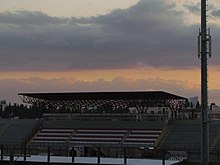Usuário(a):Xaris333/translate
Famagusta municipal stadium[editar | editar código-fonte]

After being denied access to the Estádio GSE, the club did not have a venue for training. They initially practiced at the Saint Lukas pitch (Proodou) in Famagusta[1][2] and began efforts to build a privately owned stadium. In December 1948 Israel made a CYP£3,000 Doação to the city of Famagusta, in gratitude for aid by its inhabitants to Judeu refugees, for a community-service project. Gabriel Makris, a Famagusta Vereador and Nea Salamina footballer, supported the association's recommendation to build the stadium. The city council recognized the "financial assistance granted to the Jews to create Municipal Sports Stadium, which is available to Famagustans for the promotion and spread of mass popular sport". The stadium was available to Nea Salamina and other sports clubs.[3]
In early 1949, volunteer construction work began[1][2] on a municipal stadium in Saint John Famagusta parish. The stadium—the first in Cyprus with a roof over the stands—was built by supporters of the club and footballers and completed in 1952.[4] It served as Nea Salamina's headquarters from 1952 to 1953.[5][1]
In 1953, after the unification of football federations, Nea Salamina used Estádio GSE.[6][3] The city's Municipal Stadium was used by the team for training.[7] This period lasted until 1974, when Famagusta was occupied by the Exército da Turquia after the Turkish invasion in Cyprus and the club was forced to move its headquarters.[8]
Ammochostos Stadium[editar | editar código-fonte]

From 1974 to 1991 Nea Salamina used GSZ Stadium in Lárnaca, Dasaki Stadium in Dasaki Achnas, Municipal Stadium in Dherynia and Antonis Papadopoulos Stadium in Lárnaca. In 1991 the team built its own stadium, Estádio Ammochostos.
Estádio Ammochostos, owned by Nea Salamina in Larnaca, has a 5,000-seat capacity and is primarily used for football. The club offices are in the same area. The stadium is named for the town of Famagusta (em grego: Αμμόχωστος; Ammochostos), the original home of Nea Salamina before the Turkish occupation, and was built in 1991 near the refugee camps. The decision to build the stadium was made in 1989; construction began in December of that year, and thanks to club supporters in Cyprus and abroad, the Cyprus Sports Organisation and volunteer labor, the stadium was completed on schedule.[5][9] The first Nea Salamina Famagusta game in the new stadium was played on Saturday, 12 October 1991, against Evagoras Paphos. Nea Salamina won, 4–1.[10] The stadium hosted the 1992 UEFA European Under-16 Championship final on 17 May 1992 between Germany and Spain, which Germany won 2–1.
Emblem and colors[editar | editar código-fonte]

Nea Salamina's emblem incorporates the Chama Olímpica, the color red and the five rings of the Jogos Olímpicos.[11] The club's colors during its first two years were yellow and crimson,[11][12] when it was part of the Cyprus Amateur Football Federation. After 1950, the governing council changed its colors to red and white:[11][12] red symbolizing power, and white symbolizing peace. Red-and-white striped jerseys were chosen because they resembled those worn by Olympiakos Piraeus.[11]
- ↑ a b c Erro de citação: Etiqueta
<ref>inválida; não foi fornecido texto para as refs de nomeMEL141 - ↑ a b Meletiou 2011, p. 199
- ↑ a b Stilianou & Georgiou 1988, p. 25
- ↑ Stilianou & Georgiou 1988, p. 189
- ↑ a b Erro de citação: Etiqueta
<ref>inválida; não foi fornecido texto para as refs de nomeΑΜΜ1 - ↑ Erro de citação: Etiqueta
<ref>inválida; não foi fornecido texto para as refs de nomeMEL212 - ↑ Stilianou & Georgiou 1988, p. 78
- ↑ Erro de citação: Etiqueta
<ref>inválida; não foi fornecido texto para as refs de nome1974S - ↑ Stilianou 1998, p. 188
- ↑ Stilianou 1998, p. 191
- ↑ a b c d Stilianou & Georgiou 1988, p. 4
- ↑ a b Meletiou 2011, p. 196
